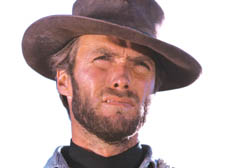|
|
 |
| |

Clint Eastwood, the iconic Man With No Name |
Western classic that’s beautifully shot
THE GOOD, THE BAD AND THE UGLY
Directed by Sergio Leone
Certificate 15
SERGIO Leone’s immense Western is back on a big screen and even if you’ve seen it countless times on telly, it’s worth a trip to the cinema.
The tale of a trio of bandits searching for a cache of looted army gold brings together three fine actors. Clint Eastwood, Lee Van Cleef and Eli Wallach spend their days shooting people, double crossing one and all, spitting gobs of tobacco into the dust and scowling into the sun. The American Civil War provides the stage for these grim adventurers to travel across the plains in search of a grave that contains cash not corpses
The Good, The Bad and the Ugly is always thought of as a Clint Eastwood film, but Wallach’s Mexican gunslinger, the magnificently named Tuco Benedicto Pacifico Juan Maria Ramirez, is the more fascinating character.
He grizzles and groans and spits out his speeches – and what speeches they are.
Tuco’s greed is his only motive: we meet him and Eastwood’s character, Blondie (aka The Man With No Name), while they are perpetrating a scam that requires Blondie to hand in Tuco to the authorities and collect a $3,000 bounty. As Tuco is about to be hanged, Blondie shoots the rope from round his neck and the pair canter off into the sunset. But Blondie soon tires of the game and abandons Tuco in the desert: he survives and becomes hell-bent on revenge. Later, Tuco catches Blondie and subjects him to a similar fate.
But things go wrong when they come across a stagecoach of dead and dying soldiers, one of whom has the secret of the whereabouts of the missing loot. Tuco has to keep Blondie long enough to discover the name on a grave that holds the $200,000 – a name one of the dying soldiers passed on.
The cinematography is a new experience in a theatre. Leone uses long shots to pull you in: the opening scene has the camera panning through the expanse of the desert and suddenly, bang, there is a close-up of a grizzled, sun-burnt face of a desperado.
The technique is used throughout the film; it gives you a creepy feeling that some kind of desperate murderer is sneaking up on you. It also helps bring alive the oppressive, hazy heat of the south-west, and how such a climate can drive its inhabitants insane.
It was not an expensive film to shoot. Leone’s limited budget means vast tracts are without dialogue: it is cheaper to film without sound and then dub over effects or music. It means the audience can concentrate on the movements of the leading players. The gaps in speech mimic the spaces between towns.
It’s a grimy movie – another fact that makes it stand out. In classic Hollywood Westerns, the sheer dirt of life back then is often glossed over. Can you imagine John Wayne or James Stewart looking like Leone’s desperate hobos?
Leone used weather-beaten characters from the Spanish sierras.
With a super ending, the power of this last instalment of the three films Leone and Eastwood made together will live with you long after the creaky 1960s credits have rolled. |
 |
|
 |
| |
|
 |
|

